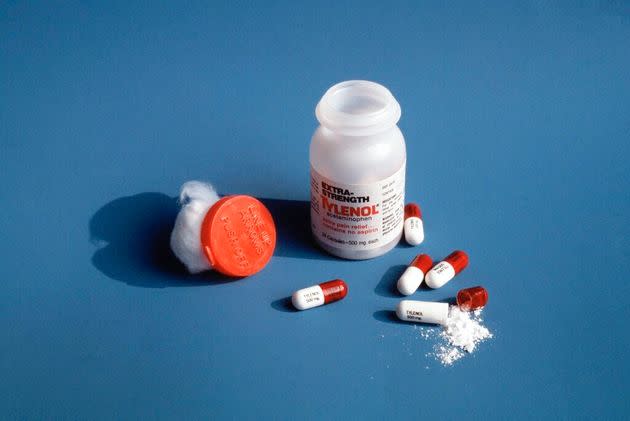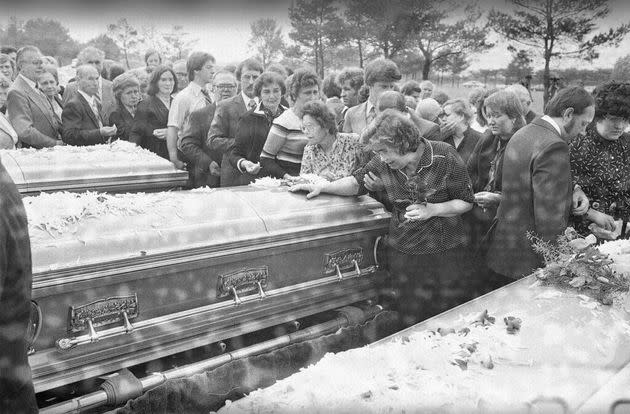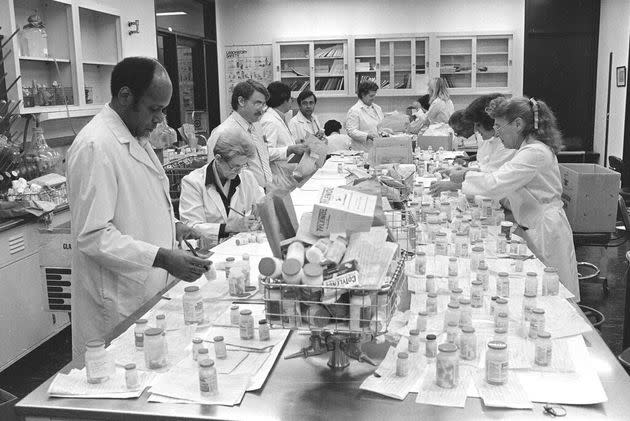The Tylenol Murders Forever Changed What’s In Your Medicine Cabinet
This is an excerpt from our true crime newsletter, Suspicious Circumstances, which sends the biggest unsolved mysteries, white collar scandals, and captivating cases straight to your inbox every week.Sign up here.
Just before sunrise on Wednesday, Sept. 29, 1982, a seventh-grader living near Chicago’s O’Hare airport woke up with a head cold and was given an Extra-Strength Tylenol capsule by her parents. She was dead before 10 a.m., the first of seven people that day in the Chicago area who unknowingly took Tylenol capsules laced with fatal doses of cyanide.
No one has ever been charged with the killings, and last month, the leading suspect, James Lewis, died at age 76 in his Cambridge, Massachusetts, home. The unsolved case had far-reaching implications for consumer safety. The way you open a bottle of over-the-counter medication is a direct result of authorities’ response to the crisis — and the fear that gripped the nation after it was revealed that someone had poisoned capsules in random bottles of Tylenol in what the Chicago medical examiner called a diabolical game of Russian roulette. The quick thinking of first responders, Chicago officials and Johnson & Johnson, the makers of Tylenol, arguably saved the lives of an unknown number of potential victims.

The Victims
Mary Kellerman, 12, lived with her parents, Dennis and Jeanna Kellerman, in the Chicago suburb of Elk Grove Village. She was their only child. At 4 p.m. on Sept. 28, the day before her daughter’s death, Jeanna Kellerman bought a 50-count bottle of Extra-Strength Tylenol at a nearby Jewel grocery store. The next morning, Mary took one of the capsules and collapsed on the bathroom floor. She was rushed to the hospital and died soon after.
Adam Janus, 27, was a postal worker in suburban Arlington Heights, about 7 miles north of the Kellermans’ home. An hour after Mary Kellerman was pronounced dead, he bought a bottle of Extra-Strength Tylenol at a different Jewel, in Arlington Heights. Janus, a Polish immigrant who was married with two kids, had taken a sick day because he was having mild chest pains. After taking the Tylenol for his pain, he collapsed in his bedroom. He died at Northwest Community Hospital at 3:15 p.m.
Mary “Lynn” Reiner, 27, had just given birth to her and her husband Edwin’s fourth child a week before. On Sept. 29, she bought a 50-count bottle of regular Tylenol at Frank’s Finer Foods in Winfield, the suburb 30 miles west of Chicago where the family lived. At 3:30 p.m., she took some Tylenol from the new bottle, became comatose and was transported to Central DuPage Hospital. The following morning, she was taken off life support and pronounced dead at the same hospital where she had just delivered her baby.

A 1974 wedding photo shows Mary McFarland, right.
Stanley Janus, 25, joined other grief-stricken members of the Janus family, including his brother Joe — with whom he co-owned an auto parts store — at their brother Adam’s house hours after his death. There, Stanley and his 20-year-old wife of three months, Theresa Janus, each took capsules of Extra-Strength Tylenol from the bottle Adam had purchased earlier. Immediately, the newlyweds indicated they had chest pains and were rushed to Northwest Community Hospital. Stanley was pronounced dead just after 8 p.m., at the same hospital where his brother had died five hours earlier.
Theresa Janus was taken off life support just after noon on Friday, Oct. 1.
Mary McFarland, 31, a divorced mother of two young children, was working at Illinois Bell Telephone in Lombard — between Winfield and Elk Grove Village — when she told her co-workers she had a headache. At about 6:30 p.m., she took Extra-Strength Tylenol from a pill case in her purse and collapsed. She died at Good Samaritan Hospital in Downers Grove the next morning just after 3 a.m.
Paula Prince, 35, was a United Airlines flight attendant. Shortly after 9 p.m. on Sept. 29, after landing at O’Hare, she stopped by a Walgreens near her home in Chicago’s Old Town neighborhood. There she bought a 24-count bottle of Extra-Strength Tylenol, a purchase that was captured on the drugstore’s surveillance camera. (Unfortunately, security cameras were only installed near the cash registers, so there is no footage of anyone placing the tainted Tylenol on the shelves.) Prince died after taking a single capsule from that bottle, although the exact time is unknown — her sister and a friend discovered her body two days later in her apartment.

Helena Tarasewicz, foreground, right, mother of Tylenol cyanide victim Theresa Tarasewicz Janus, weeps over the casket containing her daughter's body during graveside services at Maryhill Cemetery in Niles, Illinois, on Oct. 6, 1982.
The Investigation
Stanley Janus’ death was at first determined to be a heart attack. After the other two deaths in his house, however, officials suspected carbon monoxide poisoning. Arlington Heights fire lieutenant Chuck Kramer — who had been treating Stanley when, he said, Theresa grabbed his arm and collapsed herself — was among the first to suspect that the Janus family members had been poisoned from the Tylenol they had all taken.
Kramer said he contacted his friend Helen Jensen, the Arlington Heights village nurse and public health official, who agreed poisoning was possible. Like a clichéd plot in a movie, however, the police and the medical examiner laughed at her and dismissed her concerns, Kramer and Jensen told CBS News in a September 2022 interview — even after she presented them with the Tylenol bottle from Janus’ home and the receipt for it she had found when searching through his trash.
“There are six capsules missing. There are three people dead. There has to be a correlation,” Jensen said she told authorities.
Later, Kramer spoke to another Arlington Heights fire lieutenant, Phil Cappitelli, who told him of another case of someone dying after taking Tylenol: 12-year-old Mary Kellerman.
Their suspicions were confirmed in the early hours of Sept. 30, when a lab technician confirmed that blood tests taken of both Kellerman and Adam Janus contained lethal doses of cyanide. Shortly afterward, the coroner’s office, which was charged with testing the recovered Tylenol bottles from the victims, verified that it had found cyanide in the capsules.
Officials took action. A task force comprising local, state and federal officials was formed to investigate the poisonings and locate what the attorney general called “a madman hell-bent on doing something like this.” In a midnight news conference on Oct. 2, Mayor Jane M. Byrne announced that all bottles of Tylenol were being yanked from store shelves in Chicago, urged residents not to take the Tylenol they had at home and to turn in any bottles they had to police or fire departments.
Police passed out fliers and drove through Chicago-area streets with bullhorns, warning residents not to take Tylenol.
Then Johnson & Johnson, Tylenol’s parent company, made an unprecedented decision: It recalled all its Tylenol capsule products in the U.S. — 31 million bottles valued at about $100 million (about $316 million in today’s dollars).
Johnson & Johnson, the FDA and other government agencies had already begun testing Tylenol products for cyanide. In the end, they found only three more bottles that contained poisoned Tylenol capsules, including an unsold bottle at a drugstore in Schaumburg, where Mary Kellerman, the first victim, attended junior high, and two bottles turned in by residents in Wheaton (next to Winfield) and Chicago.
Investigators ruled out the possibility that the capsules had been altered at plants or during the distribution process, but they remained stumped. Modern DNA testing on the bottles has proven to be virtually useless, because the bottles were handled by so many people who didn’t wear gloves, from consumers and scientists to investigators themselves.

James Lewis is escorted through Boston's Logan Airport on Oct. 13, 1995, after being released from federal prison.
Red Herrings
Police pursued disparate leads, including an eccentric longtime Jewel dockhand named Roger Arnold, who lived and worked in another western Chicago suburb and had previously made comments about wanting to poison people. When investigators searched his house, according to a Chicago Tribune investigation, they found white powder, chemical lab equipment, and guides on making explosives, drugs and poisons — including potassium cyanide. The white powder police found, however, was later identified as potassium carbonate, not cyanide.
At one point, Arnold worked at the same Melrose Park warehouse as Mary Reiner’s father — the men occasionally ate lunch and commuted together — and Arnold’s wife had been treated at a psychiatric hospital across the street from the Jewel store where Reiner bought her tainted bottle of Tylenol. Although police couldn’t make a case against Arnold, he was widely publicized as a suspect and later said in a court filing that his “reputation and life stability was destroyed” as a result. When he found out who had originally given his name to police, Arnold decided to retaliate against the tipster: Marty Sinclair, who owned a bar that Arnold frequented. Instead, he shot and killed another man, John Stanisha, who closely resembled Sinclair. Though Arnold went to prison for killing only Stanisha, some local police detectives continued to maintain that he was the Tylenol poisoner.
The Extortion Letter
Investigators largely discounted Arnold — and other supposed “copycats” — after the arrival of a letter at Johnson & Johnson’s headquarters in New Brunswick, New Jersey, first reported on Oct. 8 — one week after the last Tylenol poisoning death. Authorities would not know that at the time, of course, so they took the letter writer’s threat seriously: Wire $1 million to a Chicago bank account or more poisonings would follow. “As you can see, it is easy to get buyers to swallow the bitter pill,” the letter, handwritten in all-caps letters, began, warning the “gentlemen” of Johnson & Johnson not to involve the FBI or Chicago police.
Investigators discovered that the letter was written by Lewis, an itinerant, dodgy tax accountant who said it had been intended to frame his wife’s former employer, Frederick Miller McCahey, whose last paychecks to his employees bounced. The bank account number specified in the anonymous letter belonged to McCahey — an account that had been closed, so Johnson & Johnson couldn’t have wired money to it even if it tried.
Once identified, Lewis and his wife became fugitives. He was finally arrested on Dec. 13, 1982, in New York City — where he claimed (but could never prove) to have been when the Tylenol poisonings took place. Lewis had posted letters from Manhattan to the Chicago Tribune proclaiming his innocence, so investigators concentrated their search on places he could read the Tribune. In the pre-internet era, that meant newsstands and libraries. A reference librarian spotted him at the New York Public Library, contacted authorities and he was arrested on extortion charges. Though authorities could never prove that he was the Tylenol poisoner, it did come out that he had a criminal past: He served prison time for tax fraud and in 1978 was charged in Kansas City with capital murder in the dismemberment killing of Raymond West, a 78-year-old man who had hired him to do accounting work. The charges were dismissed, however, because a judge determined police lacked probable cause to arrest him and had never read him his Miranda warning. He also escaped prosecution on sexual assault charges in 2004 for an alleged attack on a Cambridge, Massachusetts, woman, but only after spending three years in jail awaiting trial.
But Lewis was never prosecuted for the Tylenol murders: Instead, he was convicted for attempted extortion because of the threatening letter in October 1983, and served 12 years of a 20-year sentence in federal prison.
(If) He Did It
While authorities were able to rule out the possibility that the Tylenol capsules had been contaminated during manufacturing or shipping, it is still unclear exactly how the poisoner laced the capsules with the deadly potassium cyanide. The most persuasive theory came from the prime suspect himself, Lewis, who offered a hypothetical scenario as to how the killer might have spiked the pills.
FBI special agent Roy Lane Jr. told the Chicago Tribune that investigators met with Lewis in prison several times in late 1983 after he volunteered to help with the investigation. In addition to interviews, Lewis offered detailed “speculation” flow charts and drawings of how the crimes might have been committed, beginning with obtaining the cyanide and other materials and books. Then the killer would “acquire a capsule inventory,” poison the pills, acquire bottles from store shelves, and then switch out their contents either in the store or somewhere outside it — such as in a car, a restaurant, while sitting on a bench or even while walking. Finally the killer would place the contaminated bottle back on the store shelf.
Lewis also explained how the poisoner could prepare the mixture and “adulterate” the capsules without being poisoned himself. In one method, he demonstrated how a cutting board could be drilled with holes to hold capsule shells, which would be filled by using a flat knife to brush the cyanide-laced powder across the board, where it fell neatly into each capsule.
Investigators thought they were close to a confession, but Lewis continued to maintain his innocence. After his death on July 9, the man who successfully prosecuted Lewis for attempted extortion, former Assistant U.S. Attorney Jeremy Margolis, said in a statement to the Chicago Tribune, “I was saddened to learn of James Lewis’ death, not because he’s dead, but because he didn’t die in prison.”

Chicago City Health Department employees test Tylenol medicines for cyanide content at a city lab, Oct. 4, 1982.
Consumer Safety
The tragic killings almost ruined Johnson & Johnson, but the Tylenol makers’ decisive response is applauded to this day by government agencies, public relations firms and shareholders and enabled the company to miraculously rebound after seeing its sales drop from a whopping 35% share of the market to 8%.
In addition to its massive recall of 31 million bottles of Tylenol, Johnson & Johnson offered a $100,000 reward for information leading to the conviction of the perpetrator — and lost 1,000 times that amount in sales. What’s more, it offered refunds or free replacements for the Tylenol that customers had discarded, and discounted its products. In 1983, Johnson & Johnson settled a lawsuit brought by the families of the victims for an undisclosed sum.
Perhaps most important, Johnson & Johnson worked with the FDA to institute “tamper-proof” packaging: foil seals, wads of cotton stuffed above the pills, childproof caps and plastic strips around the bottles all offered different levels of protection to consumers. All became the industry standard for over-the-counter medication.
Tylenol also introduced an alternative to the capsules — the “caplet,” a gel-coated tablet that was easier to swallow than traditional pills but also less vulnerable to “adulteration.”
And Tylenol sales rebounded. The company’s efforts spawned numerous case studies in crisis management, corporate responsibility and consumer behavior. Legislation soon followed: In October 1983, Congress passed the “Tylenol bill,” making it a federal offense to tamper with food, drug cosmetic or other consumer products, punishable by life in prison.
Those actions closed a sad chapter of Chicago history and helped ensure it didn’t repeat elsewhere in the U.S. But with Lewis dead and no other suspects, the case might always remain unresolved: More than 40 years later, a motive for the crimes remains a mystery.
